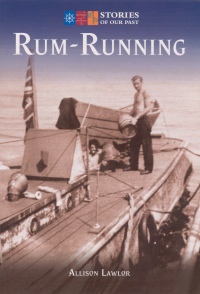| ________________
CM . . .
. Volume XVI Number 40. . . .June 18, 2010
excerpt:
Rum-Running is the inaugural text in a promising series called “Stories of Our Past,” published by the largest publisher in Canada east of Toronto, Nimbus Publishing. It chronicles the period from the early 1920s to the mid-1930s, when the United States’ rather disastrous experiment with Prohibition led to a brisk, profitable (and dangerous) smuggling of alcohol from Canada and other locales before the act was repealed in 1933. The Atlantic coast stretching from Massachusetts down to Florida came to be known as Rum Row. In this geographic area, a line of ships just outside of the twelve-mile jurisdictional limit would off-load cargoes of liquor to faster contact boats in international waters. Those contact boats, evading trade within United States jurisdiction, would then bring liquor into America, and criminal organizations would distribute it. An episode in Maritime history recently revisited, Rum-Running is a welcome addition to school library shelves. Ample historical context is provided by Allison Lawlor before she dives into fascinating accounts of the trade, the sometimes larger-than-life figures engaged in it, the vessels used to carry the illicit cargo, and the communities impacted by it. She traces the temperance movement, the series of acts in the United States and various Canadian provinces passed in favour of Prohibition, showing how those dovetail with economic lean times, all of which made liquor smuggling an attractive option for struggling communities in the Maritimes. For example, the islands of St. Pierre and Miquelon, French territories used by Canadian distillers, became havens for smugglers and a key point in the distribution of liquor down to the States. Lawlor goes into considerable detail on how a typical smuggling operation was run, including descriptions of how various vessels were refitted for their new role in smuggling, forms of radio communication, and ingenious diversionary or escape tactics used if boats were caught. She devotes a chapter each to rum running in Nova Scotia, New Brunswick, and Prince Edward Island, identifying the primary movers and shakers in the rum running trade (everyone from Royal Navy captains to “booze czars” operating out of hotels to enterprising businessmen). She then moves on to detail the ongoing efforts to fight smuggling, such as the Canadian Preventive Service working at cracking down on illicit trade with less effectiveness than the US Coast Guard. The aftermath of Prohibition is also briefly treated, showing how the legal repercussions of millions of dollars of unpaid tariffs by the smugglers are counterbalanced by the government’s not-altogether sterling behaviour in reaping taxes for which refunds are impossible to claim. Although Lawlor dramatizes some of the stand-offs and other key episodes, there are drier stretches in the text in which the passive voice takes over more often than necessary. Overall, however, there is little to find unappealing in what should be an invaluable resource on a period in Maritime history hitherto untapped. Lawlor, a freelance writer with a background in journalism, does an admirable job gleaning facts from secondary and primary sources, such as local newspapers and archival materials, and stitching them together into a coherent and readable narrative. This book is sure to open the eyes of some readers to how their hometowns played (somewhat notorious) roles in international smuggling operations. What could have improved the book even more is a timeline of key events. For those not as well-versed in nautical and boating terms, a glossary and labeled diagrams of the different types of vessels may have been helpful too. As a resource for students studying Canadian history, the text provides a bibliography, image source index, sidebars with supplemental information, a subject index, and several maps that could lead to more in-depth research projects. Without either romanticizing the exploits of rum-runners or outrightly condemning them, Lawlor notes that, during that time, rum runners were not frowned upon but were seen as middlemen providing an essential service. Ultimately, the moral ramifications are left open for the reader to consider after hearing from the participants and eyewitnesses in the trade, as well as those who fought to stamp it out. Lawlor notes that, after Prohibition, many of those involved in liquor smuggling wanted to “put the era behind them,” and it was only in the 1980s that people started “talking more openly and retelling their stories,” thereby reopening a fascinating, if controversial, era in Atlantic Canadian history. We are glad that this is a history that is not only talked about, with its panoply of distinct voices and perspectives, but now, is also written down. Recommended. Ellen Wu is currently a student in the MLIS program at the University of British Columbia in Vancouver, BC.
To comment
on this title or this review, send mail to cm@umanitoba.ca.
Copyright © the Manitoba Library Association. Reproduction for personal
use is permitted only if this copyright notice is maintained. Any
other reproduction is prohibited without permission.
NEXT REVIEW
| TABLE OF CONTENTS FOR THIS ISSUE
- June 18, 2010.
AUTHORS
| TITLES|
MEDIA REVIEWS |
PROFILES |
BACK ISSUES |
SEARCH |
CMARCHIVE |
HOME
|
